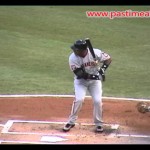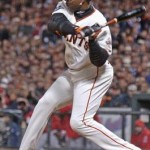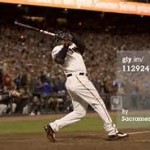There has been no greater practitioner of “perfect-timing” in consistently hitting a baseball than Barry Bonds. A close “second” and “third” were Ted Williams and Hank Aaron. 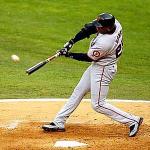
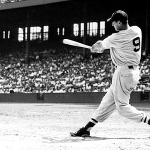
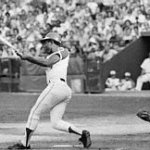 But, because of their natural, ill-contrived tendencies to “stride” (even in the slightest), all three fell short of the expanded “greatness” they could have achieved. Ted was the last to hit .400, in an era when “power-pitching” was not as profuse as today, and the “bull-pens” markedly deficient. The next player to hit .400 will be a batter who does not stride. But he will also have to be one who has eliminated all or most other “margins for error” as well.
But, because of their natural, ill-contrived tendencies to “stride” (even in the slightest), all three fell short of the expanded “greatness” they could have achieved. Ted was the last to hit .400, in an era when “power-pitching” was not as profuse as today, and the “bull-pens” markedly deficient. The next player to hit .400 will be a batter who does not stride. But he will also have to be one who has eliminated all or most other “margins for error” as well.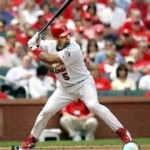
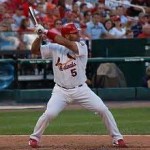


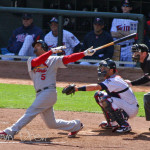
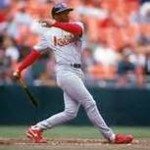
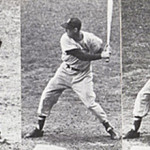

Albert Pujols had the right idea when he devised a low-stance, with his hands and bat just below his shoulders, at what would be close to a “high strike.”  He attempted not-to-stride, but to simply raise the heel of his front foot, then forcefully press down as he was to commence with his swing. He had become one of Baseball’s more successful hitters. Then for some reason he decided to raise his hands and bat above his shoulders
He attempted not-to-stride, but to simply raise the heel of his front foot, then forcefully press down as he was to commence with his swing. He had become one of Baseball’s more successful hitters. Then for some reason he decided to raise his hands and bat above his shoulders , and his decline began, but not simply for that reason alone. The high bat and hands merely added another “margin for error” which, combined with others, exacerbated all his legitimate attempts at perfecting his swing. From his “low stance,” and lower hands and bat, he had perfect balance and power-potential. The only thing missing was “how to effect his front-foot-plant” while not striding! Instead of twisting his front heel and then pressing down forcefully, he simply should have pointed his front foot at a 120 degree angle to the pitcher (as did DiMaggio
, and his decline began, but not simply for that reason alone. The high bat and hands merely added another “margin for error” which, combined with others, exacerbated all his legitimate attempts at perfecting his swing. From his “low stance,” and lower hands and bat, he had perfect balance and power-potential. The only thing missing was “how to effect his front-foot-plant” while not striding! Instead of twisting his front heel and then pressing down forcefully, he simply should have pointed his front foot at a 120 degree angle to the pitcher (as did DiMaggio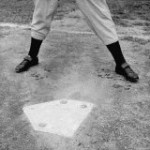 and Williams
and Williams 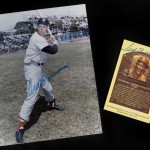
 ). Even with his senior-citizen status, this year (2014), he is having his best year with the Angels. His “low-center of gravity” is the basis for any further success he has. The margins for error that he would have to eliminate to become a more formidable batter are these:
). Even with his senior-citizen status, this year (2014), he is having his best year with the Angels. His “low-center of gravity” is the basis for any further success he has. The margins for error that he would have to eliminate to become a more formidable batter are these:
Bring his arms, hands, and bat down to his former height  .
.
Point his front foot to 120 angle to the pitcher (like DiMaggio) .
.
Grab the bat with both hands evenly, not having his left hand tucked under his right.
And “choke-up” just a little. At this stage of his “game” he needs as much bat-control as is possible (look at Barry Bonds and Ted Williams )- 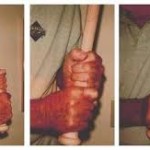
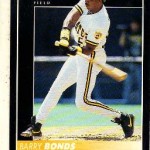 .
.
Pujols has eliminated (to a degree) the most debilitating aspect of batting deficiency. At least his head is still in his “non-stride.” But the extra movement of the twisting front foot (from a point where the toes are pointed to Home – plate) prevents absolute focus on the “pure” foot-plant. Compare the following two foot-plants: 

 . Kemp, in the first photo, is subject to strain of ankle and knee, while no strain is imminent in Williams’ swing.
. Kemp, in the first photo, is subject to strain of ankle and knee, while no strain is imminent in Williams’ swing.
Without a stride the batter can be assured of the best possible visual acuity for tracking the in-coming pitch. And without a stride, the batter can exact a faster time-sequence with which to initiate the action of the swing. The swing cannot begin until the front foot is planted. (Have you ever tried to swing a bat with the front foot off the ground?) Anyone who believes he NEEDS to stride (because, since Baseball’s inception, everyone has always accepted the “need to stride,” especially for the application of maximum power), does not have a clear understanding of how that slight movement affects the “timing” mechanism to the “perfect swing.”
The following conditioning sequence will facilitate a habit-forming regimen to accommodate the essential training needed to begin the conquest of stagnant hitting deficiency.
4-STEP HITTING DRILL: (This should be done without a bat first, then with a bat after total 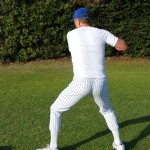
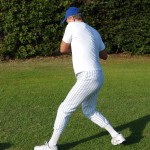
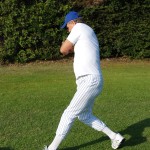
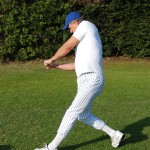
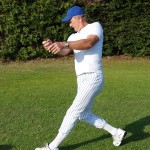 coordination has been mastered.)
coordination has been mastered.)
Step 1 – Assume a position of maximum strength and balance. Get as low a stance as to not feel too uncomfortable, with feet spread at the distance of your normal stride. (Remember, a low stance gives you a natural advantage of a smaller strike zone as well as a fundamental posture for stronger and quicker movement. If you understand the value of this “principle,” any physical discomfort you seem to have with a low stance will diminish as your body becomes acclimated through repetition and positive results.) Then begin the repetition of the entire hip-shoulder “weight-transfer,” step by step. Repeat five attempts focusing on the straightening of the front leg, by pushing down hard on the front foot with the feeling of pushing your body backward. If the body does actually fall backwards, off balance, your back foot and bent knee are not doing what are required of them.
Step 2– Focus on the action of the back leg. With a low stance, as you assume that the transfer of weight is imminent, drive the back bent-knee forward with force, rotating from the outside of the big toe of the back foot. Focus on maintaining a bent back leg during the simulation, but be conscious of the other three stages (especially the front leg).
Step 3—Focus on front shoulder action. As front foot is planting, be focused on how forcefully you can shrug and pull the front shoulder up and backward. If the movement feels weak, it’s probably because the hips did not initiate the action.
Step 4—Focus on back shoulder and elbow. When the front shoulder shrugs, the back shoulder (with elbow) automatically lowers. The muscles of the Pectoral (in chest) and Latissimus (in back) areas drive the elbow down and forward ahead of the top hand. The hand is thus in a palm-up position to force a flat bat through the ball. So focus on the backside of the upper body coming through. But be conscious that the front side seems to be initiating the action.
After these four steps have been mastered, use a bat and go through them again, using a batting tee until mastery is attained. After that, go through the same procedure, this time combining step one with step two, and step three with step four, making it a two-step drill. (Then, step two with step four, and step one with step three.)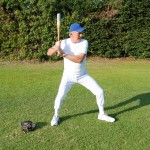
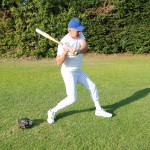
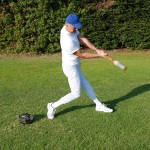
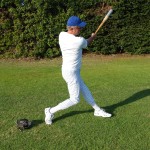
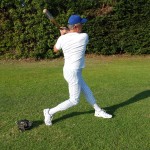
Remember, you are working to see how fast you can complete the entire action “perfectly.” Only perfect practice will make perfect, so perform the drills at full speed with the expectation of reacting faster as the mechanics of the swing are perfected. Eventually you can move the tee to cover all the areas of the strike zone. Remember also, to assure that the head not move, refrain from taking a stride—you really don’t need it anyway if you perfect the “four step” drill.
Also Remember: When assuming your stance, always have the front foot pointed at a 120 degree angle (or slightly less)to the pitcher, not a 90 degree angle (or less) which many batters assume because they have been told that it will keep their front hip and shoulder from opening too quickly. The front foot, at a 120 degree angle, will allow the weight transfer during the swing to be more accommodating to the front knee, ankle, and foot joints. While, at 90 degrees or less, the tension on the front foot, ankle, and knee can have a dire affect on the ligaments and tendons while the body is twisting and turning on its rotating axes. Harold Baines and Ryan Howard can attribute their knee and ankle problems, as well as their erratic batting proficiency, to the extremely awkward front foot positioning in their stances (and plant)(Can you imagine what would happen to a power-pitcher if his front foot planted at a 95 degree angle to Home-plate, rather than the normal 180 degrees  ? )Just look at the front foot positioning of outstanding hitters such as Ted Williams and Joe DiMaggio, to validate the proper transfer of weight during the swing.
? )Just look at the front foot positioning of outstanding hitters such as Ted Williams and Joe DiMaggio, to validate the proper transfer of weight during the swing.
 END.
END.
